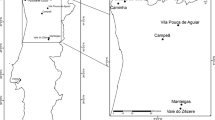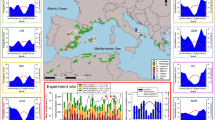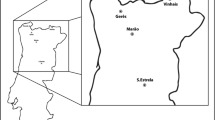Abstract
The Spanish populations of Pinus sylvestris L. occupy differentiated sites and must therefore include structural variations to cope with varied climate conditions. This study compares wood anatomical traits of P. sylvestris from ten Spanish regions of provenance with contrasting climates, taking into account the effects of region of provenance and tree nested within provenance on variation in wood biometry. In general, the effect of both sources of variation (provenance and tree) on wood biometry was highly significant. Most of the anatomical variations observed were intra-populational (at the tree level), although variation explained by provenance was high for some parameters (e.g., ray frequency and ray parenchyma cell frequency), suggesting high environmental influence. Trees in the driest region, growing in a Mediterranean phytoclimate, were characterized by large tracheid lumens, suggesting more efficient water conduction. They also had thick cell walls, which would reduce the risk of cavitation caused by high implosion stress during periods of drought, as well as a high ray tracheid frequency, implying greater water storage capacity in the sapwood. The population with greatest growth, located in an oroboreal phytoclimate, was characterized by large bordered pits and long tracheids, which would reduce resistivity in water transport. At higher altitudes, tracheid lumen diameter and resin canal diameter tended to be smaller, and intertracheid wall strength was greater. Results are discussed in relation to adaptation of the species to growth demands and frost.




Similar content being viewed by others
References
Alía R, Moro-Serrano J, Notivol E (2001) Genetic variability of Scots pine (Pinus sylvestris) provenances in Spain: Growth traits and survival. Silva Fenn 35:27–38
Allué-Andrade JL (1990) Atlas fitoclimático de España: taxonomías. Instituto Nacional de Investigaciones Agrarias, Madrid
Castellarnau JM (1883) Estudio micrográfico del sistema leñoso de las coníferas y en general del Género Pinus. Anales de la Sociedad Española de Historia Natural XII:(1–2)
Catalán G, Gil P, Galera RM, Martín S, Agúndez D, Alía R (1991) Regiones de procedencia de Pinus sylvestris L. y Pinus nigra Arn. subsp. salzmannii (Dunal). Instituto Nacional para la Conservación de la Naturaleza, Madrid
Choat B, Cobb AR, Jansen S (2008) Structure and function of bordered pits: new discoveries and impacts on whole-plant hydraulic function. New Phytol 177:608–625. doi:10.1111/j.1469-8137.2007.02317.x
Chudnyi AV (1974) The importance of investigating the resin-duct system in Scots pine wood in selection for resin productivity. Genetika, selektsiya, semenovodstvo i introduktsiya lesnykh porod, Moscow
Climent J, Chambel MR, Perez E, Gil L, Pardos J (2002) Relationship between heartwood radius and early radial growth, tree age, and climate in Pinus canariensis. Can J For Res 32:103–111
Cochard H, Froux F, Mayr S, Coutand C (2004) Xylem wall collapse in water-stressed pine needles. Plant Physiol 134:401–408. doi:10.1104/pp.103.028357
Cochard H, Barigah ST, Kleinhentz M, Eshel A (2008) Is xylem cavitation resistance a relevant criterion for screening drought resistance among Prunus species? J Plant Physiol 165:976–982. doi:10.1016/j.jplph.2007.07.020
Costa-Tenorio M, García-Antón M, Morla-Juriasti C, Sainz-Ollero H (1990) La evolución de los bosques de la Península Ibérica: una interpretación basada en datos paleobiogeográficos. Ecología 1:31–58
Davis SD, Sperry JS, Hacke UG (1999) The relationship between xylem conduit diameter and cavitation caused by freezing. Am J Bot 86:1367–1372
Eilmann B, Zweifel R, Buchmann N, Fonti P, Rigling A (2009) Drought-induced adaptation of the xylem in Scots pine and pubescent oak. Tree Physiol 29:1011–1020. doi:10.1093/treephys/tpp035
Esteban LG, Guindeo A (1988) Anatomía e identificación de maderas de coníferas españolas. Aitim, Madrid
Esteban LG, de Palacios P, Guindeo A, García L, Lázaro I, González L, Rodríguez Y, García F, Bobadilla I, Camacho A (2002) Anatomía e identificación de maderas de coníferas a nivel de especie/Anatomy and identification of conifers wood as a species. Fundación Conde del Valle de Salazar-Mundi-Prensa, Madrid
Esteban LG, Martín JA, de Palacios P, García-Fernández F, López R (2010) Adaptive anatomy of Pinus halepensis trees from different Mediterranean environments in Spain. Trees Struct Funct 24:19–30. doi:10.1007/s00468-009-0375-3
Ezquerra FJ, Gil L (2001) Wood anatomy and stress distribution in the stem of Pinus pinaster Ait. Invest Agr Sist Recur For 10:165–177
Fajardo-Alcántara M, Venturas M, Gil L (2009) Caracterización y recuperación de posibles ejemplares de Pinus x rhaetica Brügger en el pinar de Puebla de Lillo (León). In: Digital Proceedings of the 5° Congreso forestal español. 21–25 September, Ávila, Spain
Gil L, López R, García-Mateos A, González-Doncel I (2009) Seed provenance and fire-related reproductive traits of Pinus pinaster in Central Spain. Int J Wildland Fire 18:1003–1009
Hacke UG, Sperry JS, Pockman WT, Davis SD, McCulloh KA (2001) Trends in wood density and structure are linked to prevention of xylem implosion by negative pressure. Oecologia 126:457–461
Herms DA, Mattson WJ (1992) The dilemma of plants: To grow or defend. Q Rev Biol 67:283–335
IAWA Committee (2004) IAWA list of microscopic features for softwood identification. IAWA J 25:1–70
Jane FW (1970) The Structure of wood, 2nd edn. A & C Black, London
Ladell JT (1959) A new method of measuring tracheid length. Forestry 32:124–125
Maherali H, DeLucia EH (2000) Xylem conductivity and vulnerability to cavitation of ponderosa pine growing in contrasting climates. Tree Physiol 20:859–867
Martínez-García F, Montero G (2000) Typology of Pinus sylvestris L. forests in Spain. Invest Agr: Sist Recur For (Special issue) 1:41–65
Martinez-Vilalta J, Pinol J (2002) Drought-induced mortality and hydraulic architecture in pine populations of the NE Iberian Peninsula. For Ecol Manage 161:247–256
Mayr S, Wolfschwenger M, Bauer H (2002) Winter-drought induced embolism in Norway spruce (Picea abies) at the Alpine timberline. Physiol Plant 115:74–80
Mayr S, Hacke U, Schmid P, Schwienbacher F, Gruber A (2006) Frost drought in conifers at the alpine timberline: xylem dysfunction and adaptations. Ecology 87:3175–3185
McCullagh P, Nelder JA (1989) Generalized linear models, 2nd edn. Chapman & Hall, London
Mencuccini M, Grace J, Fioravanti M (1997) Biomechanical and hydraulic determinants of tree structure in Scots pine: anatomical characteristics. Tree Physiol 17:105–113
Peraza C (1964) Estudio de las maderas de coníferas españolas y de la zona norte de Marruecos. Instituto Forestal de Investigaciones y Experiencias, Madrid
Pickard WF (2008) Laticifers and secretory ducts: two other tube systems in plants. New Phytol 177:877–887. doi:10.1111/j.1469-8137.2007.02323.x
Pittermann J, Sperry J (2003) Tracheid diameter is the key trait determining the extent of freezing-induced embolism in conifers. Tree Physiol 23:907–914
Prus-Glowacki W, Stephan BR (1994) Genetic variation of Pinus sylvestris from Spain in relation to other European populations. Silvae Genet 43:7–14
Robledo-Arnuncio JJ, Collada C, Alía R, Gil L (2005) Genetic structure of montane isolates of Pinus sylvestris L. in a Mediterranean refugial are. J Biogeogr 32:595–605. doi:10.1111/j.1365-2699.2004.01196.x
Rosner S, Klein A, Müller U, Karlsson B (2007) Hydraulic and mechanical properties of young Norway spruce clones related to growth and wood structure. Tree Physiol 27:1165–1178
Sheriff DW, Whitehead D (1984) Photosynthesis and wood structure in Pinus radiata D. Don during dehydration and immediately after rewatering. Plant Cell Environ 7:53–62
Soranzo N, Alía R, Provan J, Powell W (2000) Patterns of variation at mitochondrial sequence-tagged-site locus provides new insights into the postglacial history of European Pinus sylvestris populations. Mol Ecol 9:1205–1211
Sperry JS (2003) Evolution of water transport and xylem structure. Int J Plant Sci 164:S115–S127
Sperry JS, Sullivan JEM (1992) Xylem embolism in response to freeze-thaw cycles and water-stress in ring-porous, diffuse-porous, and conifer species. Plant Physiol 100:605–613
Sperry JS, Hacke UG, Pittermann J (2006) Size and function in conifer tracheids and angiosperm vessels. Am J Bot 93:1490–1500
Sterck FJ, Zweifel R, Sass-Klaassen U, Chowdhury Q (2008) Persisting soil drought reduces leaf specific conductivity in Scots pine (Pinus sylvestris) and pubescent oak (Quercus pubescens). Tree Physiol 28:529–536
Tyree MT, Zimmermann MH (2002) Xylem structure and the ascent of sap. Springer Series in Wood Science, 2nd edn. Springer, New York
Willis KJ, Bennet KD, Birks HJB (1998) The late quaternary dynamics of pines in Europe. In: Richardson DM (ed) Ecology and biogeography of Pinus. Cambridge University Press, New York, pp 107–121
Woodward S (1992) Responses of gymnosperm bark tissues to fungal infections. In: Blanchette RA, Biggs AR (eds) Defense mechanisms of woody plants against fungi. Springer, Berlin, pp 62–75
Acknowledgments
The authors are grateful to Prof. Luis Gil (Universidad Politécnica de Madrid) for reviewing the manuscript, making suggestions and providing a critique.
Author information
Authors and Affiliations
Corresponding author
Additional information
Communicated by S. Mayr.
Rights and permissions
About this article
Cite this article
Martín, J.A., Esteban, L.G., de Palacios, P. et al. Variation in wood anatomical traits of Pinus sylvestris L. between Spanish regions of provenance. Trees 24, 1017–1028 (2010). https://doi.org/10.1007/s00468-010-0471-4
Received:
Revised:
Accepted:
Published:
Issue Date:
DOI: https://doi.org/10.1007/s00468-010-0471-4




